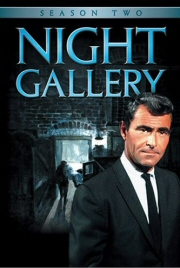 With the temperature dropping, it's time to find someone to keep you warm. Find your hookups with our online dating guide!
With the temperature dropping, it's time to find someone to keep you warm. Find your hookups with our online dating guide!
- Horror
- 1971
- Buy the DVD
Reviewed by Ross Ruediger
()
irector Guillermo del Toro (“Pan’s Labyrinth,” the “Hellboy” films) is a massive “Night Gallery” fan – so much so that he not only contributes three commentary tracks to this set, but was directly instrumental in finally getting Season Two released on DVD. Indeed, he’s such a “Night Gallery” enthusiast that when he begins his first of three commentaries for the set, he even bemoans the fact that he only gets to do three. Accordingly, when watching these episodes, it doesn’t take long to see the series’ influence in his work, especially in something like “Pan’s Labyrinth,” which may as well be a movie-length episode of “Night Gallery.”
But more on that later.
“Night Gallery” was Rod Serling’s follow-up to “The Twilight Zone,” and while the show is not as consistently successful as its predecessor, there’s enough strong material here to make it a more than worthwhile viewing experience. Whereas “Zone” tended toward the sci-fi, “Gallery” unveils its stories through the lens of gothic horror. And although both series share a mission to tell morality plays, those that work strongest here usually have the same general premise: people doing dirty deeds that do not go unpunished. Each hour-long episode – shot in eye-popping early ‘70s color – is comprised of between two and four separate stories; some are as long as 30 minutes, and others are as short as five. It’s usually the shortest tales – typically played for laughs – that manage to thud the loudest, but that’s OK, because it frees up the bulk of the series to concentrate on the longer, dramatic tales, which are pretty evenly spread out in a 50/50 hit-or-miss ratio. When this show is firing on every cylinder, it is mesmerizing TV, and even when it’s not, it’s still watchable. As with “The Twilight Zone,” Serling is the host, standing in the Night Gallery, surrounded by elaborate, macabre paintings that represent each of the tales told. (One wonders what ended up happening to each of these works. No doubt they are expensive collector’s items for the fans that can afford them.)
Some highlights: “The Caterpillar,” with Laurence Harvey, is undoubtedly a standout, and is frequently remembered as one of the most famous stories to come out of this show. (Even my better half vividly recalled it from when she was a kid and was elated to finally see it again after all these years.) It involves an earwig, and if you’ve seen “Star Trek II: The Wrath of Khan,” then you probably don’t need to know anything more about it. “Camera Obscura” follows a greedy tax collector (Rene Auberjonois) into a past where the tortured souls of men who are as unsympathetic as he is reside for eternity. “Class of ‘99” features Vincent Price as the principal of a graduating class with a bleak commencement ceremony. The visually stunning “Marmalade Wine” stars Robert Morse (“Mad Men”) as a weary traveler, moving through a surreal landscape, and it’s well worth watching just for the look of it. “A Fear of Spiders” will take you back to the infamous cockroach installment of “Creepshow,” while “The Phantom Farmhouse” is a strangely erotic story of human-to-beast transformation starring David McCallum and David Carradine.
The standout tale on the set, however, is only about 15 minutes long. It’s called “Silent Snow, Secret Snow,” and it has almost no dialogue, and is instead narrated by Orson Welles. Based on the classic short story by Conrad Aiken, this piece of television is about a boy (Radames Pera of “Kung Fu”) who lives in a dream world covered in snow as a means of escape from the ordinary. I watched it twice before listening to Del Toro’s commentary track and – surprise! – it’s one of, if not his favorite piece of “Night Gallery” ever. He lumps it together with two other tales – “Brenda” and “The Messiah on Mott Street” – as being the series’ trilogy about children and the loss of innocence, and it’s fascinating to listen to him dissect these stories. Del Toro is versed in “Night Gallery” the way other genre fans are in “Star Trek” and “Buffy.” He’s able to offer up one profound interpretation after another, and, frankly, it is a shame he’s only on three commentaries here, as his opinions greatly enhance the experience of watching this show. So, yes, when you take into account t that he grew up viewing this sort of fare, you can easily see how del Toro ended up helming the gothic dreamworld created by a child in “Pan’s Labyrinth.”
Special Features: In addition to the three aforementioned commentaries from del Toro, there are three more from “Night Gallery” historians Scott Skelton and Jim Benson. “Revisiting the Gallery: A Look Back” is a 30-minute featurette that includes interviews with numerous people who worked both behind and in front of the “Night Gallery” camera,” while “Art Gallery: The Paintings in ‘Rod Serling’s Night Gallery’” is fairly self-explanatory and runs about three-and-a-half minutes. Lastly, the set includes nearly 13 minutes worth of NBC promos that were used to promote the show back in the day.
You can follow us on Twitter and Facebook for content updates. Also, sign up for our email list for weekly updates and check us out on Google+ as well.











